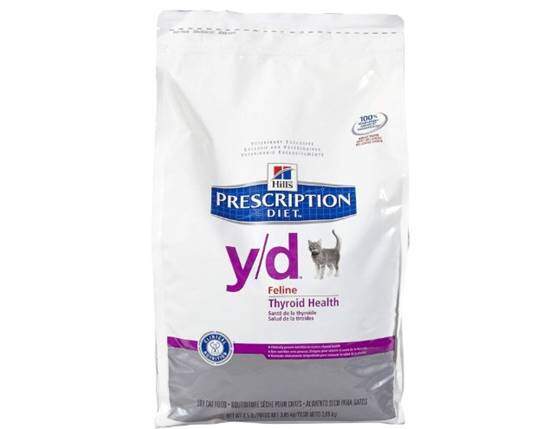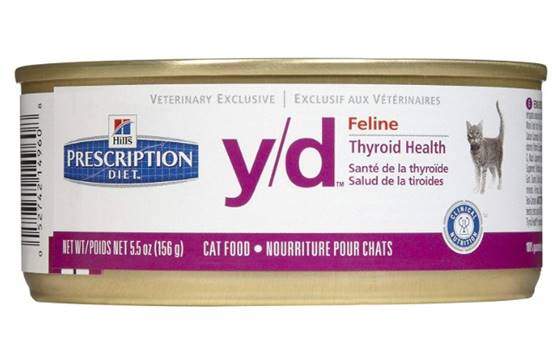Hyperthyroidism is a glandular disorder that results from increased production and consequently elevated blood level of thyroxine hormone (T4). Thyroxine is one of the thyroid hormones.
Usually, one or both the thyroid glands may enlarge or become overactive due to various reasons including thyroid adenocarcinomas (tumors), adenoma (non-cancerous), environmental factors such as BPA, PBDEs, and PCB exposure, among other factors.
Older cats are more vulnerable to hyperthyroidism (starting from 12-13 years onward). However, this disorder is not breed or gender specific.
Some of the commonly noted symptoms of hyperthyroidism include weight loss, increased appetite, vomiting, diarrhea, weakness, poor coat quality (greasy or matted fur), hyperactivity, restlessness, among others.
Treating hyperthyroidism
Various approaches are used in treating this disorder including lifelong use of anti-thyroid medication such as methimazole pill often known as Tapazole, radioactive iodine treatment, a surgical option where the affected gland is removed or going for iodine restricted diets (therapeutic diets).
In this discussion, we will be focusing on low iodine diets and mention a few brands that may be helpful.
Do iodine restricted diets work?
Research on the “Effect of Feeding an Iodine‐Restricted Diet in Cats with Spontaneous Hyperthyroidism” published in the Journal of Veterinary Internal Medicine concludes that these diets do help reduce the thyroxine concentration (T4). This supports them.
A second study on “Comparison of health parameters in normal cats fed a limited iodine prescription food vs a conventional diet” indicated that there was no significant difference between cats fed on restricted-iodine diets and those that had normal diets for two years. This indicates that these diets are safe even on healthy cats.
However, this second study only considered healthy middle-aged cats (2-5 years) and the findings might not be the same for the case of older or geriatric ones.
Therefore, therapeutic diet option is often recommended in cases where other treatments seem to be impossible due to other medical conditions.
While looking at iodine in cats functions, we did mention the fact that this mineral form part of the thyroid hormones. Therefore, its absence means that the body cannot secrete thyroid hormones.
Furthermore, for these diets to work, all other diets including commercial, cat treats, and homemade diets must also have a low amount of this mineral.
Whereas, iodine restricted diet for cats is one of the ways used to manage hyperthyroidism. The Cornel University College of Veterinary Medicine warns that it is “somewhat controversial because of concerns about the effects of long-term iodine restriction on overall health and the possibility that such a diet may actually backfire and worsen hyperthyroidism.”
Also, reducing iodine may affect these foods palatability and some cats may not want to eat them.
How to make therapeutic diets a success
While trying to manage hyperthyroidism using therapeutic diets, it is important to ensure that the foods you opt for are nutritionally balanced, have enough calories and are meant for these pets. They need to help your feline friend recover from muscle loss and gain weight.
Also, they should be able to manage diabetes and glucose intolerance since these conditions are often noted hyperthyroid cats.
Low carb foods will help those diabetic. However, you should avoid dry foods (go for wet ones) and reduce the non-animal source of protein since these pets are strict carnivores.
Since wet foods have lower or no vegetables, fruits or grains as opposed to dry ones. We recommend you go for wet canned food instead of the dry one.
Finally, dry foods often have higher plant proteins and carbohydrates. Therefore, avoid dry kibble foods.
Best low iodine cat foods
The idea is not looking for iodine-free diets for cats but those whose levels have been reduced since these pets still need this mineral. Reducing the amount may help bring thyroid hormone level to normal in some cases.
You must have heard Hill’s low iodine cat food or prescription for thyroid health. They have two brands of food.
1. Hill’s Prescription Diet y/d Feline Thyroid Health (Dry)
This is a low iodine (0.2 ppm) iodine) dry cat food which according to its manufacturer, Hills Pet, “is a safe, effective and easy way to manage thyroid health. Clinically proven to improve thyroid health in 3 weeks when fed as the sole source of nutrition.”
It also has regulated sodium and phosphorus as well as added omega 3 fatty acids, L-carnitine, taurine, and antioxidants making it also good for kidney, urinary and heart health.

2. Hill’s® Prescription Diet® y/d® Feline Canned food
Its ingredients and functions are like the dry food above. The only difference is that it is a canned wet cat food meaning it has more moisture which makes it even better for your cat’s renal function.

If you decide to go for the above foods, ensure your feline friend does not access treats, other foods or liquids apart from water including cat dental chews.
Critics of the Hill’s y/d diet have several issues that genuinely need to be mentioned and thoroughly examined which include:
- Their use will not treat some underlying causes such as tumors and they may continue growing.
- Felines on this diet cannot eat any other food including homemade ones and treats.
- There is a lifetime dependency on the diet
- There are no long-term studies to show the effect of foods with restricted iodine on healthy cats if they happen to share this food. Such cats can be iodine-deficient and this can trigger more thyroid hormone production that may result in thyroid gland enlargement and goiter. Also according to a research low iodine diets can potentially cause hyperthyroidism.
- The protein, fat and carbohydrate composition does not match the recommended amounts, i.e., they have lower protein and higher carbs which are not ideal for cats being strict carnivores.
- Protein source for the dry version is from plants including soybean mill run, corn gluten meal, and so on and not an animal source.
Low iodine cat food recipes
If you opt for homemade recipes, you need to avoid foods that are high in iodine including eggs especially the yolk, fish diets (some have high fire-retardant PBDEs which affect thyroid gland function), dairy, soy, seaweeds and avoid adding iodized salt to these foods.
Research has shown that “cats that preferred fish or liver and giblets flavors of canned cat food had an increased risk,” of hyperthyroidism while another one linked soy isoflavones with higher thyroxine (T4).
The United States Department of Agriculture has a searchable database where you can search for various foods and check their iodine content as well as other ingredients.
Iodine free cat treats
While you may make every effort to buy commercial or make homemade diets that are low in iodine, you need to ensure the various treats you give these pets are also low in this mineral.

Ok good information but not enough, my cat won’t eat Hills so I resorted to Instinct lamb but I’m still afraid she isn’t getting enough fat to put on some weight so do you know of a homemade iodine deficient recipe. Please help
Some foods low in iodine include fresh beef, veal, lamb, pork, fresh chicken, and turkey as well as fresh-water fish (such as carp, river bass, lake trout, and river perch). Avoid, avoid organ meats, seafood, egg yolks, whole eggs, any canned meats, and don’t add any salt in your recipe.
We currently haven’t come up with specific recipes. Let your vet help you in ensuring the diets are complete and balanced nutritionally.